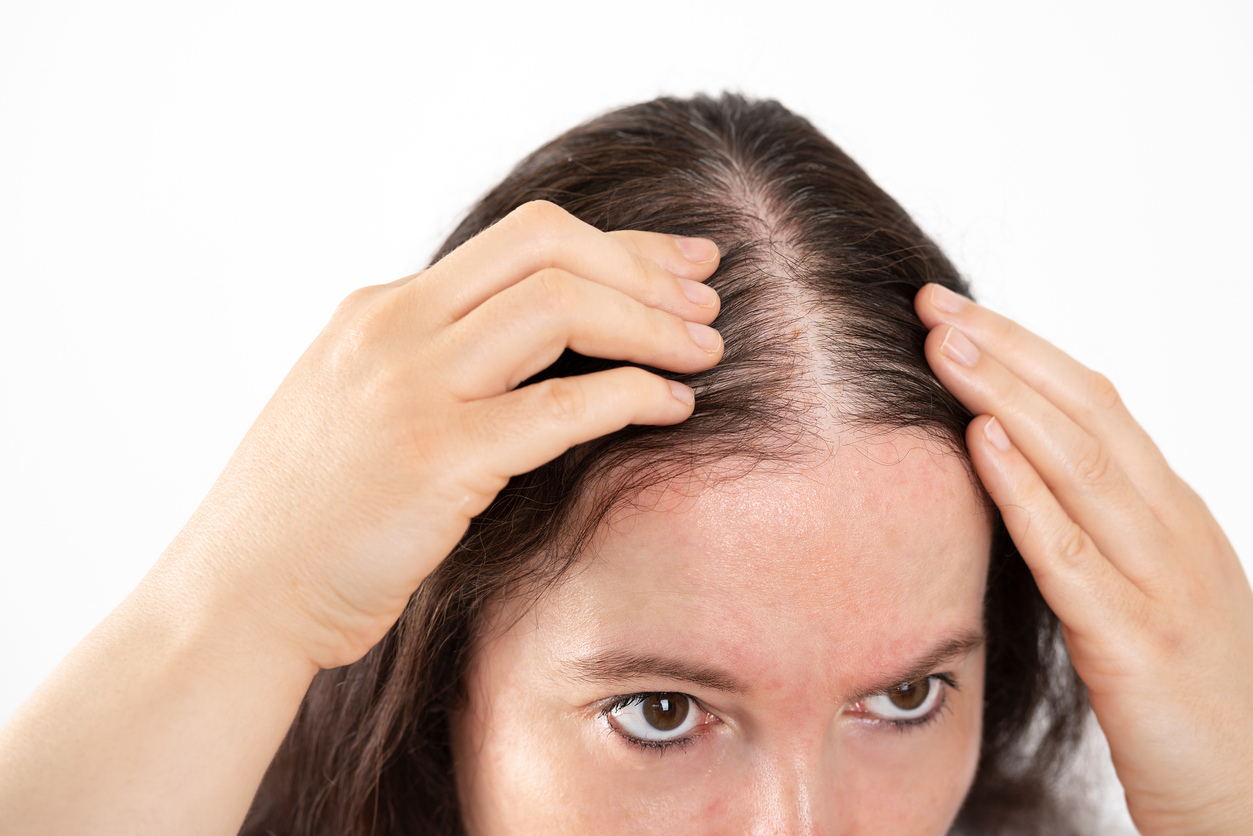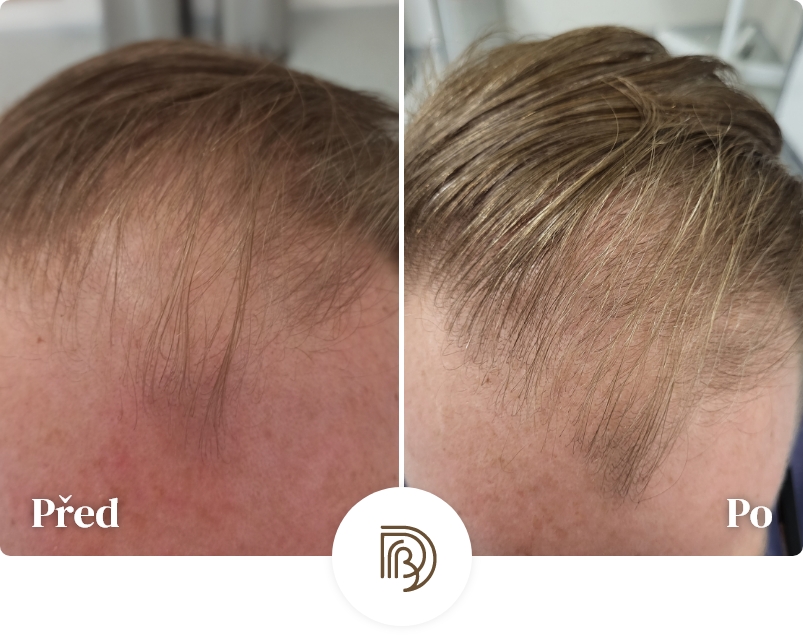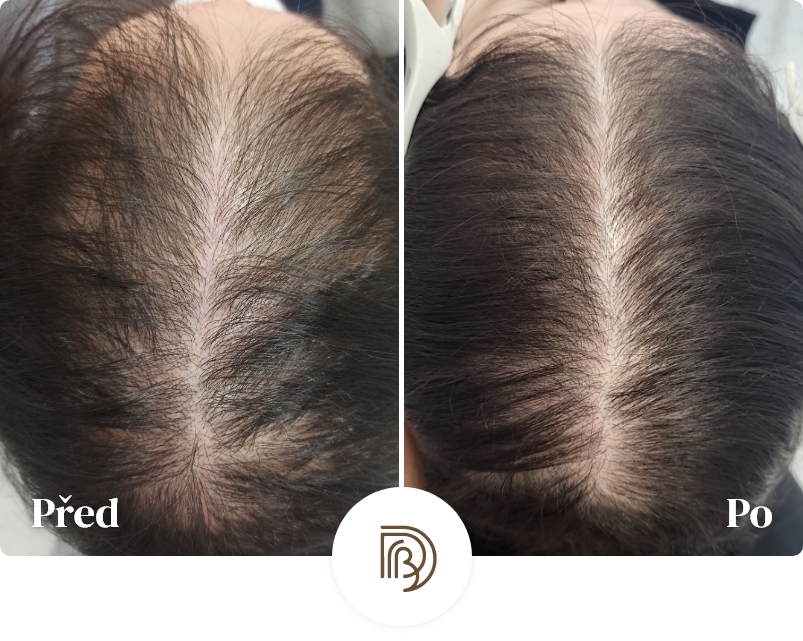
Article content
- Androgenetic alopecia in men and women
- Article content
- What is androgenetic alopecia? Understanding the most common type of hair loss
- Androgenic alopecia in men: causes, symptoms and treatment
- Androgenetic alopecia in women: causes, symptoms and treatment
- Genetics and androgenetic alopecia
- Androgenetic alopecia in children and adolescents
- How to treat androgenetic alopecia?
- Relationship between hormones and androgenetic alopecia
- Prevention of androgenetic alopecia
- Myths and facts about androgenetic alopecia
- Make an appointment
- Similar posts
There are several types of alopecia (hair loss). Androgenetic alopecia is the most common type of hair loss in both men and women. This condition has a genetic component and is related to androgens, male hormones present in both sexes. What are the causes, symptoms and treatment options for androgenetic alopecia?
What is androgenetic alopecia? Understanding the most common type of hair loss
Androgenetic alopecia, also known as male or female pattern baldness, is characterized by the gradual thinning of hair from the top and front of the scalp. Unlike Alopecia areata, it does not form bald patches. It usually begins in men during adolescence and in women after menopause. This condition is caused by a combination of genetic, hormonal and environmental factors. This is a progressive type of hair loss, which means that the hair loss occurs slowly over time.
Facts
- Androgenetic alopecia affects up to 80% of men and 40% of women
- In men, hair loss typically begins in adolescence
- In women, it typically begins after menopause
- It is progressive – hair falls out gradually
- Hair loss does not have to be permanent, hair growth can be restored with treatment
- Androgenetic alopecia has a high treatment success rate
Androgenic alopecia in men: causes, symptoms and treatment
Androgenetic alopecia in men is caused by hereditary sensitivity to dihydrotestosterone (DHT), a hormone derived from testosterone. DHT shortens the growth phase of hair follicles, it causes them to shrink and eventually stop forming new hair.
And what are the symptoms of this alopecia? Typical symptoms include a receding hairline, thinning hair on the crown of the head (roundness) and the formation of corners. The specific manifestation of this disease in men is in the beard, where the beard loss on the chin and cheeks. In this case, it is alopecia areata barbae.
There is a familial predisposition to androgenetic alopecia, with sons having five to six times the relative risk of developing the disease if their fathers had the same condition.
The most common treatment options are topical and oral minoxidil, 5-alpha reductase blockers (finasteride and dutasteride), plasmatherapy and, under certain conditions, hair transplantation.
Androgenetic alopecia in women: causes, symptoms and treatment
In women, androgenic alopecia has a strong genetic predisposition. The exact pathogenesis of this disease has not yet been fully elucidated. While androgens (male sex hormones) play a clear role in male androgenic alopecia, their role in female pattern baldness is not well understood. Most women have normal blood levels of androgens.
In women with androgenetic alopecia , there is usually diffuse thinning of the hair on the vertex and front of the scalp rather than receding hairline.
Treatment options include topical and oral minoxidil, oral spironolactone, 5-alpha reductase blockers, and plasmatherapy, mesotherapy and, under certain conditions, hair transplantation.
Genetics and androgenetic alopecia
Androgenetic alopecia is hereditary and can be inherited from both parents. It is a polygenic disease, which means that it is caused by the interaction of multiple genes. Certain genetic variations can increase the risk of androgenetic alopecia, but not every person with these genes will develop the disease. Genetic testing to assess the risk of baldness currently exists, but it is not clear what the results are telling.
Androgenetic alopecia in children and adolescents
Androgenetic alopecia can also occur in children and adolescents, although it is less common than in adults. This condition may be caused by hormonal imbalances, which may indicate more serious metabolic diseases, or by genetic factors.
Since the occurrence of this disease in children is quite rare, doctors come into contact with it very rarely. In children and especially adolescents, androgenetic alopecia can cause social isolation, depression and loss of self-esteem, which should not be taken lightly.
How to treat androgenetic alopecia?
The first choice of treatment for androgenetic alopecia, especially for early hair loss, is topical or oral minoxidil. Minoxidil works by stimulating hair growth and preventing new hair loss. Another primary pharmacological treatment for men with androgenetic alopecia is oral finasteride. And what is used next?
- Plasmatherapy
Platelet rich plasma (PRP) therapy is a relatively new method of promoting hair growth that has also begun to be used in the treatment of androgenetic alopecia. The method involves injecting the patient’s own growth factor-rich plasma into the scalp. The goal of PRP therapy is to stimulate hair growth by increasing blood flow and cellular activity in the hair follicles. Plasmatherapy alone is certainly not the first choice in the treatment of alopecia. From my own clinical practice I have experienced that plasmatherapy in combination with standard medication brings the best results.
- Topical antiandrogens
Anti-androgens are drugs that block the effects of androgens, such as DHT, on hair follicles. Topical anti-androgens are applied directly to the scalp and can be effective for both men and women with androgenetic alopecia. Common topical antiandrogens include spironolactone and flutamide. However, these medications can have side effects and are not recommended for use during pregnancy.
- Hair transplantation
Hair transplantation involves removing hair follicles from one area of the scalp and transplanting them into another area where the hair is thinning or missing. The procedure is usually performed under local anesthesia. Recovery time varies, but most patients can return to work within a few days. Hair transplant surgery can be effective in restoring lost hair, but it does not solve the alopecia problem itself. If you undergo a hair transplant and do not seek treatment for alopecia, your hair will most likely grow back after some time.
- Micropigmentation of the scalp
Scalp micropigmentation is a non-surgical cosmetic procedure in which small dots are tattooed into the scalp using microneedles to mimic the appearance of hair follicles. This procedure can be used to create the illusion of a head full of hair in people with androgenetic alopecia or those who have undergone a hair transplant. However, it is not a cure for hair loss and may require restoration every few years.
Relationship between hormones and androgenetic alopecia
Androgens such as testosterone and DHT play a key role in the development of androgenetic alopecia. Women with androgenetic alopecia may have elevated levels of androgens, such as DHEA-S, which may contribute to hair loss. Hormonal imbalances, such as those caused by polycystic ovary syndrome (PCOS), can also increase the risk of androgenic alopecia. Hormone replacement therapy (HRT) may be effective in treating androgenic alopecia in women with low estrogen levels.
Prevention of androgenetic alopecia
Although there is no foolproof way to prevent androgenetic alopecia, there are steps that can help slow or delay hair loss. These include eating a balanced diet, avoiding the use of harsh hair products, limiting stress, and quitting smoking. Maintaining a healthy lifestyle is helpful for any treatment, and for hair loss it is no exception.
Myths and facts about androgenetic alopecia
There are many myths surrounding androgenetic alopecia, including the belief that hair loss can be caused by stress or poor nutrition. While these factors may contribute to overall hair and skin health, they are not the direct cause of androgenetic alopecia. They are typically a symptom of Telogen Effluvim. Likewise, frequent hair washing or the use of hot styling tools typically do not cause hair loss, although they can damage the hair and make it look thinner.
One of the widespread myths is that hair loss only affects men, but in fact androgenic alopecia affects both men and women. Women may tend to hide hair loss, making it appear less common than it actually is.






